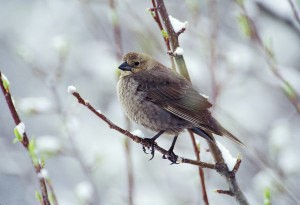Who knew that cowbirds could make good siblings? Well, decent ones, anyhow. Cowbird mothers are famous for laying their single eggs in the nests of other bird species, sometimes removing the resident’s eggs, and leaving the surrogate mother to care for a foreign nestling that is usually several times larger than her own. Because of their large size, cowbird nestlings command a greater share of food brought by the unwitting foster parents; people have also seen and filmed them shoving the legitimate nestmates out. But a group of researchers from New Zealand has found that instead of killing their nestmates, as has been observed and which seems logical from an evolutionary standpoint, cowbird nestlings are actually better off if they are not alone in the nest.
Rebecca Kilner and her colleagues from the University of Auckland found that cowbird nestlings fared better if a few of their unrelated nestlings remained to keep them company – not exactly an altruistic gesture, but one that apparently works out best for both species. Kilner wondered why this strategy was better for the cowbird than eliminating the competition and thus securing all incoming food for itself.
The researchers hypothesized that the cowbirds directly benefited from strength in numbers. To test this hypothesis, they first looked at previous cowbird experiments to determine if in those cases, the cowbird young’s growth rates were at all influenced by the number of nestmates they had. Indeed, a mathematical relationship emerged, telling the researchers that the optimal number of nestmates was about two.
Then, Kilner and her colleagues directly tested their hypothesis by experimenting with cowbirds and eastern phoebes, a common cowbird host, in New York state. Indeed, at this study site, one to three phoebe young survived in a majority of nests that had fledged a cowbird. By watching 81 nests and manipulating another 20 with different combinations of cowbird and phoebe eggs, the researchers were then able to determine that cowbird nestlings with phoebe siblings grew at a faster pace than cowbirds reared by themselves.
At which point, naturally, Kilner wanted to know exactly why cowbirds with siblings fared better. She and her colleagues filmed each of the nests twice after hatching and found that phoebe parents brought food to nests with more nestlings more frequently. Since the cowbirds took more than their fair share at each feeding, they ended up with more food overall than did those of the species nesting solo. Better yet, as the broods got older, the parents brought food more frequently – and the cowbird still took more than its fair share from its siblings.
But why did the parents feed multiple fledglings more frequently? For one thing, a single cowbird couldn’t induce its foster parents to bring as much food to the nest by itself. With a couple of extra begging beaks, the parents experienced a greater stimulus to bring food; also, they may be more responsive to the begging behaviors of their own phoebe babies.
Whatever the reason, it’s nice to know that even though cowbirds are exploiting their phoebe parents and possibly preventing some phoebes from surviving, at least they’re not wiping out the species, or any of the other species of birds whose nests they hijack, for that matter. As any parasite learns, it’s not smart to eliminate their host.


